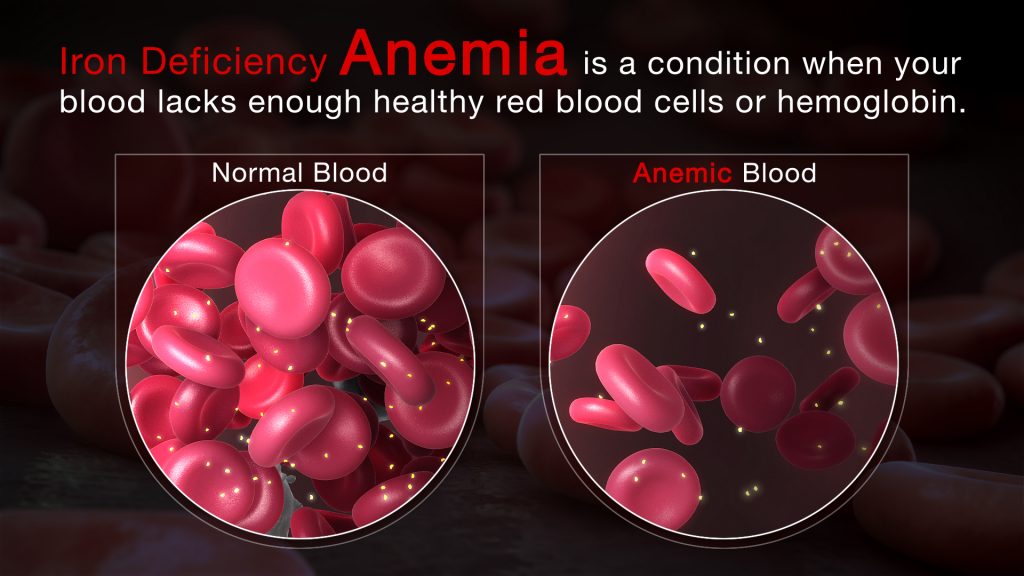Disease in Depth: Iron Deficiency Anemia

You’re tired, pale, and cranky. Or maybe you constantly have headaches and have trouble focusing on your everyday tasks. You may not just be moody—you may have iron deficiency anemia. There are many types and causes of anemia, but iron deficiency is the most common contributor to anemia.
In fact, iron deficiency is counted as one of the top ten global burdens of disease, and anemia affects over 818 million women and children worldwide. Even more alarming is that about half of those are individuals living in Asia. That means there’s probably a play of both genetics and environment since anemia disproportionately affects those in just one part of the world.
Causes of Anemia
While anemia can be caused by many things, including internal bleeding related to hemorrhoids, ulcers, or even cancer, heavy menstrual bleeding, and conditions such as celiac disease that make it difficult for your body to absorb iron, an inadequate intake of iron from foods is the most common cause.
Pregnant women, small children, and teenagers are often at the highest risk for iron deficiency anemia because their bodies need more iron than others.
Symptoms of Anemia
Symptoms include:
- Feeling weak
- Dizzy
- Fatigued
- Shortness of breath
- Intense mood swings
- Strong headaches
- Trouble concentrating, and
- Looking pale
You may even experience some hair loss and strange cravings (referred to as pica), especially for ice.
Babies and small children with iron deficiency anemia present fussy, short attention span, and growth and developmental delays. The sooner the cause of anemia is identified and corrected, the sooner these symptoms will go away and prevent further delays in children.
Iron is Important
So let’s get to the nitty-gritty of what happens in your body when you don’t get enough iron. Iron is an important part of making hemoglobin, which is a part of your red blood cells. Hemoglobin is like a little taxi that carries oxygen to every part of your body.
So when you don’t have enough iron, you can’t make enough hemoglobin; that means both fewer and smaller red blood cells, and your body can’t get enough of the oxygen it needs. So then, iron is a big deal, and you really want to be getting enough of it!
So How Can You Correct Iron Deficiency?
In most cases, it’s actually just a simple combination of iron supplements and iron-boosting foods. You may even start to feel better almost immediately, but don’t be fooled. It takes your body a long time to rebuild depleted iron stores, so even if you feel better, don’t stop taking your iron pills until your doctor tells you to because it could take up to six months to have normal iron stores again.
In fact, this is a good time to tell you not to start iron pills (or really any kind of supplements, for that matter) before consulting your doctor. Do not diagnose yourself! The reason I’m emphasizing this is that an iron deficiency may not necessarily cause your anemia—or rather, a lack of iron may not cause your iron deficiency.
Like I mentioned above, certain diseases can lead to internal bleeding that makes you lose iron, or problems absorbing it, which means you may actually be getting all the iron you need from your food already. Still, your body doesn’t know how to use it. Even if no underlying diseases were causing your iron deficiency, your doctor would determine the appropriate dosage of iron in your supplements. If you take it on your own, you may be putting yourself at risk for actually getting too much iron and even getting iron poisoning! Your doctor will diagnose the exact underlying cause of your anemia and will treat it. After all, if you don’t treat the root cause, how will the problem go away?
Two Types of Iron
Ok, now that we’ve got that bit clarified, let’s talk about what you can actually do if your doctor has told you you’re not getting enough iron in your diet. There are two types of iron you can get from your diet: heme and non-heme. Heme iron comes from animal sources such as meat, poultry, and seafood, and it is the type that is best absorbed by your body.
Non-heme iron comes from plant sources such as beans, lentils, and leafy green vegetables (think spinach a la Popeye). Most breakfast cereals are fortified with iron as well, so including some in your breakfast can help! There’s a trick you should know when planning your iron-rich meals: when you combine iron-rich foods with other foods, certain nutrients help your body absorb the iron while other foods actually hinder it.
Treatment
To help your body absorb iron, include vitamin C-rich food in the same meal, like citrus fruit or juice. But steer clear from foods that contain caffeine and calcium. That doesn’t mean you can’t have coffee anymore—keep a two-hour gap between your java and your iron!
Don’t be alarmed if you or your child is diagnosed with iron deficiency anemia. With the right foods and the right supplements, you’ll be able to reverse your symptoms and get back on track in no time—be persistent about your treatment, and don’t let up until your doctor gives you the green light!
Trending Health Topics
- ADHD
- Allergies
- Arthritis
- Bipolar Disorder
- Bunions
- Car Accidents
- Chron's Disease
- Common Cold
- COPD
- Depression
- Dry Skin
- Dry throat
- Eczema
- Fungal Infection
- GERD
- HIV/AIDS
- Hypertension
- Irritable Bowel Syndrome (IBS)
- Multiple Sclerosis
- Osteoarthritis
- Psoriasis
- Rheumatoid Arthritis
- Skin Disorders
- strep throat
- Type 2 Diabetes
- Uncategorized